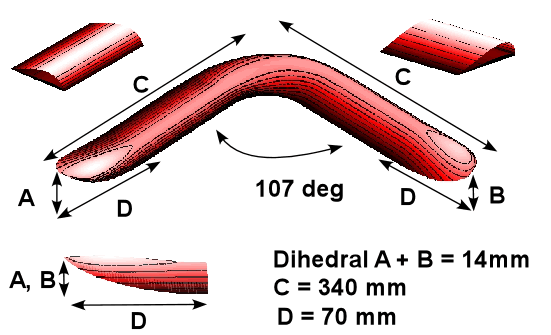How to make it
May 1, 20121. Take plywood sheet of 12mm thickness. Draw boomerang contour pattern as shown in picture above. The 107 degree angle size is not critical, just optimum. It can be more or less than 107deg. Chord length near the center of boomerang = 80 mm, and 60 mm near tips. Make wing chord length few millimeters wider as is required, because it necessarily reduces during sanding process. Also make some access length at boomerang wings tips, as it possible, that you will have to cut them during tune procedure of the boomerang.
Note:
If you make angle >>107, consider that rotation plate becomes small and it can be difficult to keep the boomerang spinning.
If you make angle of about 90 degrees, the boomerang flight trajectory circle radius is minimum. Angles <90 deg and >90 degrees increase circle radius.
2. First what you have to do is to sand dihedrals of wings. You have to make decision were is top and bottom. Put plywood boomerang on flat table and see if the tips are up or down. The traditional Australian boomerang has positive dihedral. The best choice is to find position in which the boomerang wings tips are up. (Do not care about that if your plywood is absolutely flat).
Remove some material from boomerang bottom at distance of about D=70...90 mm from both tips. It can be asymmetrical, but condition A+B = 14 mm should be satisfied.
Note:
Dihedral is the most critical part of boomerang. Boomerang model states, that dihedral determines the boomerang's trajectory. Considering D=const=70 mm, we can point out four cases:
• A+B < 14 mm gives flight trajectory pattern in which boomerang remains orientated vertically too long (lift force is orientated along spin axis) and falls down with ballistic trajectory. Then it rolls on ground making arc. Boomerang doesn't return.
• A+B = 14 mm (D=const=70 mm) gives "O" type pattern
• A+B > 14 mm gives "8" type pattern.
• A+B >> 14 mm gives cork screw pattern which goes forward. Boomerang doesn't return.
Note: other types of boomerangs different from Original Australian boomerang need other dihedral angles. For an example, threeblader or fourblader has negative angle dihedral.
3. Formation of wings profiles. Actually, boomerang is spinning rotor with blades like a helicopter or fan. The difference from fan is in angle of attack: boomerang blades should never exceed 14 degrees angle. See picture below. Take out 3...4 mm from the front edge of both boomerang's wings to get small angle of attack. This significantly increases the lift force of boomerang and prevents boomerang from bending into negative angle when plywood stress is released. Sometimes plywood bends by itself during sanding or after it.
Posted by Shivam Shivam.


